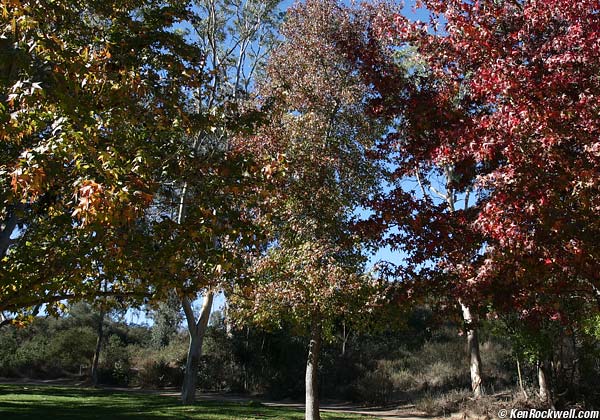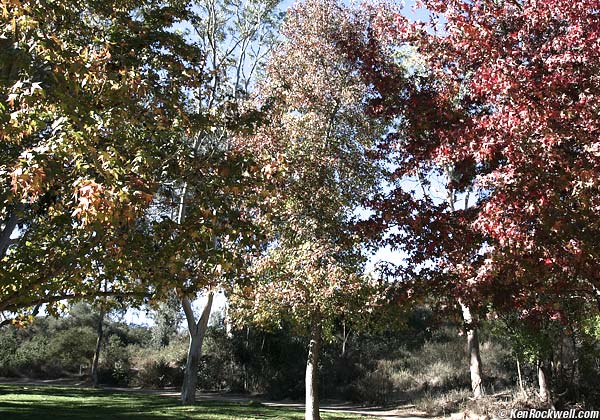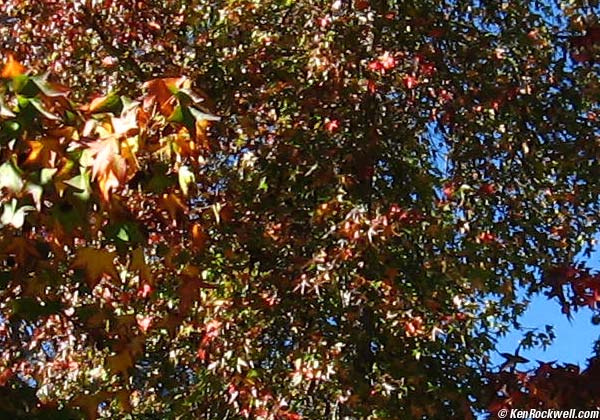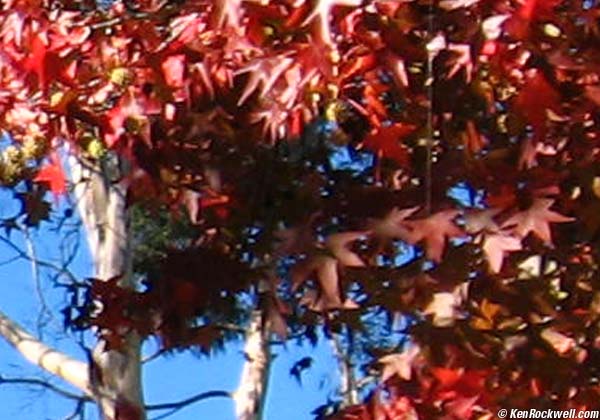Home Search Gallery How-To Books Links Workshops About Contact
|
I get my
goodies at Ritz, Amazon and Adorama. December 2006 July 2007: Also see A Comparison Between a $5 Film Camera and a $3,200 Digital Camera. Skip to: How I Did This Performance Enlargements Recommendations Here's an example of how a $150 camera can make the same photo as any other exotic camera. Roll your mouse over the image to swap between the two images. Which do you think is which? Which has better color? Which has better sharpness? Which has better highlight detail? Which has better noise performance? Roll your mouse over to compare a photo made with a $150 camera to a $5,000 camera. Sorry about the change in tilt; I used a tripod for the $5,000 camera and hand-held the $150 one. I think the better shot actually came from the cheap camera, which is the first image. Yes, if you are a geek with a microscope there are differences, but that's for geeks who look for these details as a hobby unto itself. For normal people who actually enjoy photos there isn't any difference for 80% of what you might want to shoot. Many people who read my site buy and own too many cameras. They enjoy dissecting photos for engineering details (as I often do on this site) more than they enjoy making photos. They're often the same guys who buy too many other toys. Those are the people who keep insisting you buy a more expensive camera, since it justifies their perverted hobby. It doesn't make any better photos. The $150 camera made the first shot. The $5,000 camera made the shot seen with your mouse over the image. I prefer the $150 camera in this example. Better cameras may make it easier or more pleasant to make photos, much as a better car makes it more pleasant to get someplace. A rusty Ford Pinto or a Prius gets you there just the same as a V-12 Mercedes. HOW I DID THIS back to top Introduction How I Did This Performance Enlargements Recommendations One shot was made with the $150 Canon A530. Actually it usually sells in December 2006 for about $139.95, complete with batteries, strap, cables, memory card and software. I don't use a tripod with it. I set it to its Vivid mode (explained on my A530 page). The other camera is my Canon 5D, ($3,299.99 MSRP) and a Canon 16-35mm f/2.8 L lens (1,499.99 MSRP). I had to buy my own memory card ($209), and I chose to use my own Tamrac strap ($25), B+W 77mm UV filter ($54), Gitzo G1227 carbon fibre tripod ($560) and Bogen Manfrotto 3275 410 Geared Head ($194), for a total of $5,842. I set my 5D to normal contrast and +2 color saturation. The more expensive camera costs over forty times as much as the inexpensive one. That's forty, not four. I could buy three of the inexpensive camera systems just for the sales tax on the more expensive one! The 16-35mm L lens was set to 35mm, its sharpest setting, and the A530 was at its widest setting. The two cameras make slightly differently shaped images. The A530's images are a little taller (4:3) and the 5D's images are a little wider (3:2). To get them to fit on top of each other I had to trim a little from the top and bottom of the A530's image, and trimmed the same amount from the sides of the 5D's image. I reduced both images to the same size to fit on your screen. PERFORMANCE back to top Introduction How I Did This Performance Enlargements Recommendations Look for yourself. They look equally as sharp to me. That's my point: at normal sizes, resolution doesn't matter. The $150 A530 is 5MP and the $5,000 5D is 12.7 MP. The A530 obviously has the best pixels-per-dollar value. Either makes great 12 x 18" prints if you shoot well. The color looks much better on the first image. The image you get with your mouse over the image is overexposed, so the colors are washed out. I prefer the warmer shadows on the first image. Which is which? The first one (better color; my favorite) is the $150 Canon A530! The second image (worse color and exposure) is the $5,000 Canon 5D!! This shows the importance of knowing how to use your camera over buying a fancier one. Cameras are just like cars: even if you have a Mercedes with automatic-tailgating, radar-controlled cruise control (Distronic) and navigation, you still need to keep it in lane with the steering wheel. A camera's steering wheel is the Exposure (light-dark) compensation control and the White Balance (color) control. Just like cars, regardless of how automated they are, they all need your help now and then. Why is this? Simple: I set the exposure compensation to -1.0 on the A530 to get the correct exposure. I guessed wrong on the 5D and left it at my usual -2/3 setting. The large amount of shadows in this scene caused each camera to give too much exposure to the bright parts, which washed out the color. The LCD on the $150 A530 is color accurate. The LCD on my $5,000 5D is dim, has little contrast and is too green, so I didn't see this while I was out shooting. I have no idea why the LCDs on Canon's point-and-shoots are so much better than on their SLRs; they just are. If I had left the 5D set as it came out of the box the results would have been much, much worse. The exposure would have been much lighter, and the saturation would have been much lower (0 instead of +2). Here's how the default saturation setting looks:
Canon 5D, 0 (normal) saturation and contrast. -2/3 exposure compensation. And here's how it looks at the default exposure setting:
Canon 5D, 0 (normal) saturation, contrast and exposure compensation. Art is in the eye of the beholder, and this beholder thinks the image made at the factory settings looks crappy. The $150 camera, with just two fast pushbutton settings, looks much, much better to me than a $5,000 camera left the way it came out of the box. Sadly most people who buy these don't even know where to find these adjustments, which is why I share my users guides with you. I owe you one for the 5D; for now, my Canon 30D User's Guide covers all these adjustments already. If I had been attentive enough to set the 5D more carefully I would have gotten results that matched more closely, but for the purposes of this demonstration, it was instructive that the 5D wasn't adjusted as well as the A530 was. I made hundreds of shots on different cameras and lenses this day in preparation for my upcoming Nikon-Canon Film-Digital death match. HUGE ENLARGEMENTS back to top Introduction How I Did This Performance Enlargements Recommendations How often do you print more than 12 x 18?" I do about once every two years. If I print many feet wide, it's nice to have a few more pixels. Let's compare the two at two feet wide: Section from a Two-Foot-Wide Print (60cm). This is a crop from the $150 camera at 100%. Roll your mouse over it for the crop from the $5,000 camera reduced to same pixel dimensions (a 63% crop). The two look pretty similar to me, and yes, at two feet wide, the 5D is sharper. To the 5D's advantage, this is a shadow section which looks better with the lighter exposure as the 5D was set. So why spend more than $5,000 more for a camera? Let's see what happens with a four-foot wide print: Section from a Four-Foot-Wide Print (1.2m). OK, it's sharper, but will you really look at a four-foot-wide print from as close as you view your computer screen? Probably not, but if wall-sized prints are your thing, by all means, get the excellent 5D and the fantastic L series lenses. If you're happy with spectacular 8x10" (20 x 25cm) prints, you won't be missing anything with an A530. You can take the image from the $150 camera and put it on a billboard, since people see those from hundreds of feet away. What's important? Lightness (tone) and color. Talk to any painter or artist and they'll concur: details are just details, they're not critical to the success of a color image. Note that the sharper image from the 5D, even blown up this far, still has obviously suckier color. I prefer the image from the $150 camera because it's exposed better. The 5D can get the same results, I just goofed on the exposure. This wasn't intentional, and emphasizes why the photographer is far more important than the camera Note: These print dimensions presume your computer screen is at 100DPI, as most are. RECOMMENDATIONS back to top Introduction How I Did This Performance Enlargements Recommendations Ever notice how the only people who want you to think that expensive cameras make better pictures are the same people who want to sell you one, or friends who happen to own them? The B/W shots here were made on a 50 year old camera for which I paid three dollars! It is an Agfa box camera, with fixed focus and exposure and thumbscrew film wind. You have to look through a red window to know when to stop winding each frame. Ask your favorite musician if he's as good as he is because of the brand of instrument he plays, or ask your favorite author if he writes as well as he does because of the typewriter he uses. Good tools just make it easier for people who do it all the time. My grandma was Henry Steinway's (pianos) personal assistant for decades. If you're an immortal virtuoso you play well enough to play around any faults of the instrument and possibly let people hear miniscule differences between instruments. Most likely you're the only one hearing the differences between instruments and your fans are hearing your style, not the instrument. If you're not among the immortals, lessons and practice are the way to get better. Most musicians own the axes they do because it makes it easier for them to get their signature sound, not because the instruments sound better on their own. Remember the scene in The Blues Brothers where Elwood and Jake are giving Ray Charles (proprietor of Ray's Music World) a hard time about the action being a little stiff on a keyboard they wanted to buy? Brother Ray says "let me see," sits down, proceeds to play and gets the entire city up and dancing. Of course brother Ray wanted to show that the crappy keyboard he was trying to sell Elwood and Jake wasn't defective, but it also goes to show that even a crappy instrument is no match for a master. I once saw a master player solo, unaccompanied, "Carnival of the Animals" and "Flight of the Bumblebee" on a crappy borrowed fiberglass Sousaphone (a marching band substitute for a tuba) with sticky valves. It was crazy - crazy good. Photographs come from a photographer's skill and inspiration. The camera just takes a picture after the photographer does all the work. Sorry to burst any bubbles, but I don't have any cameras to sell you. I use fancy cameras because they work under more conditions, see things from different angles, or make my work faster or easier for me. The results for 99% of my applications are the same. I'm lazy, and prefer nice tools if I have to use them all day, every day. Nice tools are nice, but just nice. They aren't necessary. Oh yes - Camera phones also can be just as good as any other camera. See here for more examples. It's all in the photographer, not the camera. PLUG If I just saved you $5,000, feel free to help me write more. It also helps me add to this site when you get your goodies through these links to Ritz, Amazon and Adorama. I use them and recommend them personally. Thanks for reading! Ken
|
Home Search Gallery How-To Books Links Workshops About Contact





